This is part of our “Bootstrapped, Profitable, & Proud” series which profiles companies that have $1MM+ in revenues, didn’t take VC, and are profitable.
In 2004, Gwyn ap Harri was a full time teacher with a couple of ideas. One was to use screen recording software for kids to demonstrate what they had learnt in the classroom. After doing a search, he didn’t find any suitable software for use in schools. One piece of software was almost there, so he contacted the creator, who lived in Beijing. After a few modifications, Gwyn put it on the market and sold it to a few schools.
He kept teaching and used the cash from those sales to fund the development of one of his other ideas: realsmart. The product started from his own frustrations. “As a teacher with all the usual pressures of getting results out of kids, I ended up teaching to the exam, and the kids weren’t learning anything real,” he says. “I had to be part of the solution, not the problem.”
So he came up with realsmart. “realsmart is certainly not a traditional piece of educational software,” according to Gwyn. “I recognised that at the epicentre of what I was doing was the young learner. So many educational products have the teacher at the centre, and they’re not.”
“realsmart is based on self assessment rather than the teacher telling you what to do,” continues Gwyn. “Students own their portfolios and can build them at their own pace. It’s based on the idea that we learn as we reflect and record our learning, not when a teacher tells us we’re a B- and could do better. It tries to help us learn like we do in the real world ie on our own, with our friends to help us, and occasionally some feedback from an expert.”
Students use realsmart to build “learning portfolios” via collaborative websites, blogs and podcasts, mind maps, and more. “It’s assessment software that doesn’t have any grades or percentages or deadlines or anything like that. They’re quite hard to explain in a few words, which is why we have loads of videos showing them off on our website,” according to Gwyn.
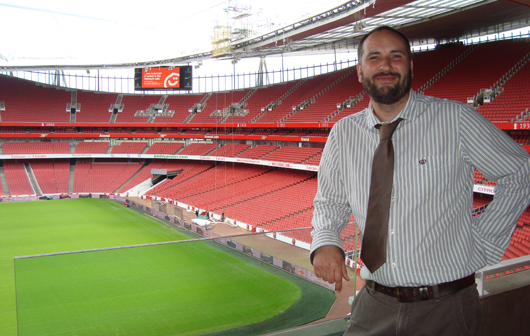
Gwyn ap Harri at Arsenal football stadium, where smartassess sponsored the Achievement Show 2010.
Getting off the ground
It wasn’t an instant hit though. “We used the money from the screen recording software to create our first version of realsmart, but it looked crap, and it didn’t do that much to be honest. It was like trying to sell half a car. We knew we weren’t going to be able to sell enough to fund the next step. We were spending more on diesel than we were bringing in.”
So Gwyn went to the bank and borrowed £70k as a business loan. “That’s all we’ve ever used of someone else’s money, and we’ve now paid it back. We made it look nice, and got just enough functionality in for it to be a goer, and off we went. After shedding blood, sweat and tears, we now fund all our development internally, but I wouldn’t be adverse to going to the bank to kickstart another project. I just wouldn’t do it by VC. Shares = blood, sweat and tears, not money.”
Was he ever tempted to go with investors? “No, and for quite a few reasons. One was that I had a bit of an experience opening an internet cafe with investors that went bad. I was determined to have control and use self-generated money. And if it didn’t work within those parameters, then it didn’t work. I’ve got to say though, in the early days, it was tough. And it took hard work, determination, guts and balls. We had a few people sniffing around, and when things are tough, it’s tempting. But I’m so glad now that we didn’t.”
Transitioning from teaching
Gwyn kept working as a teacher and then moved full time into software development in 2006. According to Gwyn, it wasn’t a tough decision to make. “I felt I’d run my course at the school I was at. I was ready for a new challenge, and to be honest, I really didn’t see it as a massive risk,” he says. “The worst that could have happened would have been that it didn’t work out and I got another teaching job. How is that risky? I saw staying in teaching as being more risky by missing my opportunity.”
It wasn’t always easy to be patient though. “The toughest thing for me is to accept that things take time, and some things are a function of time,” he says. “Especially if you are on the edge of things, you need people to catch up before you see the profitability of your great idea. You have to keep saying the same things, keep doing the same things until people believe in you. You are what you do, and if you consistently keep doing great things, you become great.”
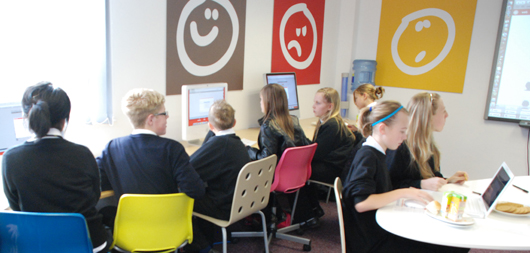
Gwyn: “We invite schools into the office, and encourage them to allow the students to decide whether they want to use our software (our REAL clients).”
Used by over 300 UK schools
Eventually, business started booming. According to Gwyn, the company is now turning over £1m+ with “a decent percentage profit” and hoping to break £2m this year. “We’ve got over 300 secondary (K12) schools using realsmart which costs schools £3k per year, and that’s about 10% of the total market in the UK,” says Gwyn. And the students are using the tools too. “Our kids have created 7k+ blogs and podcasts, 10k+ websites, 12k+ mind maps, 102k+ passports and 150k+ self-assessed portfolios, collaborating 650k+ times. Considering schools don’t really use collaborative web technologies very well, I’d say that’s success!”
Along the way, Gwyn has kept the software focused on the needs of students. “The amount of times I’ve said no to teachers demanding I allow them to put grades into realsmart! If you put grades in, the kids’ portfolios are no longer theirs. It just destroys the whole point of it. So I won’t do it.”
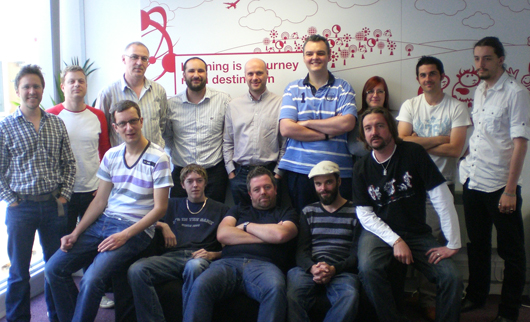
The smartassess crew.
The workplace
The company is now up to 15 full time employees but wants to keep the number right around there after a few years of rapid growth. “We want to concentrate on productivity and profitability per head,” says Gwyn. “We don’t think we’re quite there yet, and we want the solution of adding more people to be the last thing we do. We want to be a slim, agile organisation – not a fat, slow one!”
The company has an open plan office in Sheffield, UK with a separate presentation/meeting/group room. Gwyn says, “Each area is split up into sub sections. We tend to migrate and work to the place where we think we will be most productive. We’re more than comfortable working away from the office. Our sales team hardly ever come in, and we follow the sales pipeline in a Google spreadsheet. We’ve worked very hard on improving communication between ourselves, and especially between our programmers, and despite the distractions, the open plan office, with flexible quiet spaces has helped immensely with this.”
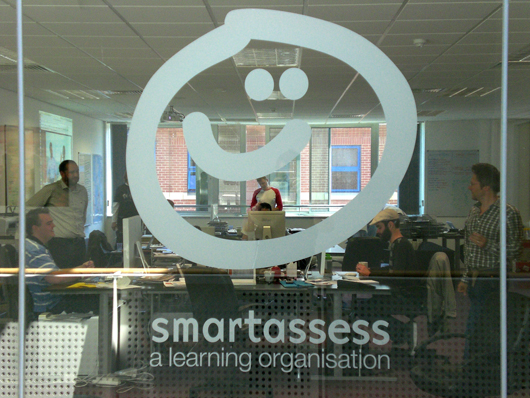
A look at the office.
Going for more than profit
Gwyn points out that profit isn’t the company’s sole goal. “We see our profit as reflecting how successful we are at what we do in the real world. We’re not ‘screwing’ schools, they’re buying into what we do and obviously get more out of our technologies than we are charging them. Win, win. As a company, creating the most profit we can isn’t the main objective. It’s the measure of how well we are doing. Our goal is to improve the learning opportunities for our children through technology. Profit is a result of us doing this successfully. It means that people understand and agree and buy in to what we are trying to do in the real world.”
And there’s definitely no plan to sell the company. “Selling smartassess would be like selling my family. You don’t ‘achieve’ a family, then sell it off for money, and try to make a better one. Well, I don’t anyway!”
Advice for starters
Here’s Gwyn’s advice to others considering starting a business:
Ask yourself if you’ve got the passion and commitment to actually do it. And is it really that much of a gamble?
Ask yourself what really is the minimum you need to do to start selling something, rather than fantasising about the big idea.
And, is what you want to do useful in real world?
A walkthrough of the smartassess office.

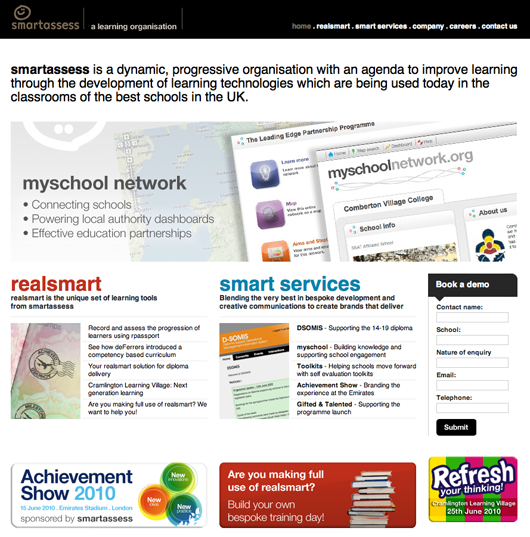
Andy T
on 22 Jun 10Does anyone NOT misread that name?
Nick F
on 22 Jun 10File this under “Worst Names for a Company.”
Matt S
on 22 Jun 10What a great name! Totally unforgettable.
Lee
on 22 Jun 10Also misread the name – thought this was a joke at first.
Amazing Rando
on 22 Jun 10Worst name … or subversively clever?
Eric
on 22 Jun 10Personally love the name, but seems like it would be a gamble in a traditionally conservative industry in the U.S. – particularly in public school systems. Not that Gwyn necessarily cares…
Anonymous Coward
on 22 Jun 10HOW ABOUT THE BUSINESS, PEOPLE? SHEESH.
Bob Hendren
on 22 Jun 10I like what the company is doing, but have to agree that I misread the name, too. Reminds me of a company I was helping setup a website years ago. The company was Open Information Systems, which the owner abbreviated Open I.S. He got clever and registered the domain name openis.com and wanted to setup the website with that until we pointed out that the domain name was ‘o-PENIS dot com’.
Adam Justice
on 22 Jun 10Matt, our company definately fits in your criteria of being bootstrapped, profitable (over 1M), and proud. We are big 37 Signals fans/users and would love to work with you if you want to profile us for the blog. Shoot me an email if you are interested!
Paul Wright
on 22 Jun 10I love the name! Playful, clever – I can’t believe people actually think they’d not have realised it when starting the company – ofcourse they did – on purpose!! May not be for US audiences, but I reckon most UK would enjoy the pun.
Kirk Franklin
on 22 Jun 10Better than being dumbassess.
Michael
on 22 Jun 10Interesting company. I will be homeschooling my children and facilitating/equipping their self-direction. Looks like this company is making it scale.
Nick Campbell
on 22 Jun 10Their logo is strikingly similar to Innocent Drinks. Which is also based in the UK. Makes me wonder about the designer.
I do think this is an interesting solution to some of the issues teachers face in educating our youth but not a complete one. I would like to see more emphasis placed on balancing teachers’ needs with students’ behaviors.
Gwyn
on 22 Jun 10Aww, guys! I wish you’d have pointed out the problem with our name 5 years ago! What a dumbassess! The kids love it by the way. I also didn’t know that someone had trademarked a human face. Cheers for that. Honestly, before the smiley, we had a rip off of a Nike tick…
Take a chance. Anyone want to know about our business?
Anonymous Coward
on 22 Jun 10Am I the only person that still does not exactly understand how/what their product does
Martin Pilkington
on 22 Jun 10@Gwyn: How long have you been in your offices? I was doing Computer Science at Sheffield until last year so I would have been next door to you guys quite a lot!
GeeIWomder
on 22 Jun 10Buzzworc bingo based on the now infamous loophole that is about to be closed in the UK.
Tell me what you do and say it without huge mistakes and maybe we can theen talk about added value.
Next up; cocaine and crack—bootstrapped w/ no socially redeemable values at all….
Matt
on 22 Jun 10I love the name. Gets people talking, thanks for sharing the info about your company.
Knaak
on 22 Jun 10@Nick Campbell: Other than both being simple faces, there really isn’t much similarity. ID’s logo has a halo, no mouth, offset eyes, a dip on top of the head, and an overall irregular shape (really round on the left, square on the right). SA’s logo has a mouth, similar sized eyes, a point on the head, overall rounded shape, and no halo.
That’s like saying the Pepsi and AT&T logos are “strikingly similar” because they are both round and have a “thick-to-thin” line(s) in them. Hey, they even both have white and blue in their logos. Quick, call the lawyers!
The Partner
on 23 Jun 10It’s so nice to see a company focused on being great to work for and great to work with. I love what you’re doing and think it’s critical that children get to learn computer skills from a combination of inspiring teachers and strong businesses. Good for you Smartassess.
I’d love to know – how does the school-to-school grapevine work for you as regards generating new leads? We are building our own online app, and although not targeted at schools, we’re hoping that we’ll be able to generate strong referrals.
A final point – anyone who ‘gets’ kids knows they will just love the name. It’s just the sort of thing that will spur them on to think that business can be fun, and to roll up their sleeves and get involved. This sort of double-entendre was at the heart of Shakespeare’s best plays and I don’t imagine we’d be stopping those being taught in schools…
Gwyn
on 23 Jun 10@Martin We’re in the innovation centre off west street, sheffield. Started off sharing an already shared office with our programmer back in 2006ish, then kept moving through the centre to bigger offices. They have a nice easy in, easy out policy.
@Anonymous Explaining what we do is the hardest challenge to us. realsmart allows you to create learning portfolios – but what are they? and why would you want one? Everyone knows what websites, blogs and mind maps are, but we have two unique tools which are the most important. How do you explain that in one sentence that everyone understands? Everyone knows what project management is, even if you do it differently, but learning through portfolios?
ahem
“Learning. For the rest of us” “A Better Way To Learn” “Learn Better with realsmart”
The best we’ve got so far is realsmart: a suite of tools that help you learn – and then we’ve whacked up loads of videos actually showing it being used. I know we can do better. We’re currently redesigning our website to explain it in more simple terms. Just noticed Beasecamp’s redesign. Much clearer, and similar to our redesign.
@GeelWomder i.don’t.understand.you
One of the unique issues we face is we design our software for kids, but we have to sell it to teachers. Anyone in a similar situation/experience? If the kids had the money and choice, we’d be bigger than M$...
Scott
on 23 Jun 10I’m with other posters in that I really don’t understand what the products do. To try to explain it by the fact that kid’s like it and that it is is kid tested and kid approved doesn’t lend much weight to it.
To say that if kids could choose to use it you’d be bigger than MS should mean little to those making choices about how best to educate kids. Just like there good reasons most children don’t decide for themselves what foods to eat and what liquids to drink, there’s a reason that children don’t make decisions about education policy. We are creatures with a biology and neurology built such that at a young age most people just have simply not yet developed the self-control, self-awareness, decision making skills, and foresight to – for example – choose healthy foods over junk foods. I’m not claiming this product is the “junk food”. I am just explaining why the “kids love it” and “kids are our users” approach do little for me as a parent and I can understand why it would do little to sway education professionals.
At any rate: congrats on the revenue milestones and success in finding something you care about and making a go at it.
Gwyn ap Harri
on 23 Jun 10@Scott please look at our website, and some of the 40 odd videos showing you what realsmart does, thanks. It’s backed by a deep and sound pedagogy. Read “A is for Apple” here http://sites.google.com/a/smartassess.com/my-learning/presentations … (being bigger than MS was a joke) Teachers and parents DO love realsmart and what it does, it’s just harder to sell it to them because they are looking at what THEY get out of it rather than what kids get out of it. We have to explain it, whereas kids just GET it. Your post highlights this issue pretty well.
Rudiger
on 25 Jun 10“smartassess is a dynamic, progressive organisation with an agenda to improve learning through the development of learning technologies which are being used today in the classrooms of the best schools in the UK.”
They lost me at “dynamic, progressive”...
Gwyn
on 25 Jun 10Agree. Working on it
Anon
on 25 Jun 10Damn. Tough crowd, eh? Note to self…don’t try to help kids learn for the sake of learning.
Jeff Oresik
on 26 Jun 10You don’t know what a portfolio is? You hire a graphic designer, do you want to see their work or their SAT scores?
RealSmart: Showing your work isn’t just for math class.
Some Dude
on 26 Jun 10smartasses is passionate about helping kids learn. We make great software(?) for some of the best schools in the UK. Kid tested, teacher approved.
Andrés Mejía
on 27 Jun 10How the fuck do they work with that vuvuzela on the office?
Bala Paranj
on 28 Jun 10How can a company that took 70 k in loan be considered as bootstrapped company?
This discussion is closed.